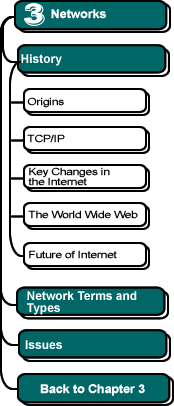

|
Domains
The domain name system dictates a very specific format for domain names.
Interestingly, unlike IP addresses, in which the portions of the address become less significant as you move from left to right, with domain names it is the opposite: as you move from left to right, the portions of the address become more significant.
calvin.edu
The most significant
portion of a domain name is the last, which is called a top-level
domain. In the case of U.S. domain names, this suffix puts the
domain into one of a number of categories, some of which are more tightly
regulated than others.
Examples:
| .org | non-profit organization | |
| .edu | four-year college or university | |
| .gov | U.S. federal government | |
| .mil | U.S. military | |
| .net | a network organization | |
| .com | originally,
a commercial business; now, almost anything |
Outside of the U.S., however, the top-level domains take the form of country codes.
Examples:
| .de | Germany | |
| .mx | Mexico | |
| .au | Australia | |
| .jp | Japan | |
| .ca | Canada | |
| .ng | Nigeria |
Thus, the American origins of the Internet produced a cultural bias that is encoded in the very structure of a domain naming scheme that divides the Internet into two groups: the U.S. and "the rest of the world."
calvin.edu
The next portion of
the address from the right is the name chosen for the domain: e.g., "calvin"
in this example.
Remember that the final suffix is the most significant portion of the address: thus, calvin.edu and calvin.com are two entirely unrelated domains.
www.calvin.edu
An
address of the above format indicates a host name. A
"host," remember, simply refers to a computer that is connected
to the Internet. Thus, a host name is simply the name of that computer
within the named domain. The host name www.calvin.edu
means that there is a computer that has been named www
within the domain calvin.edu.
Note: the name "www" is usually assigned as a convenient alias for a computer that actually has another host name: the host name of the www.calvin.edu computer is actually "ugoboy.calvin.edu." (Try it: open your Web browser and enter ugoboy.calvin.edu. You get the same result as when you enter: www.calvin.edu .)
Occasionally, you see a host name that has four parts to it. This indicates that a piece of the domain's network has been separated off into a subnet. For instance, with a subnet named "cs" within calvin.edu, a computer named "mail" would have the full host name: mail.cs.calvin.edu.
Influence
of the Domain Name System
The introduction of the domain name system in the mid-'80s made
the Internet a far more usable system, and this, too, contributed much
to the astonishing growth of the Internet during the latter half of the
decade.
![]()
![]()
This chapter was written by Jeff Nyhoff and Joel Adams. Copy editing by
Nancy Zylstra
©2005 Calvin University (formerly Calvin College), All Rights Reserved
If you encounter technical errors, contact computing@calvin.edu.